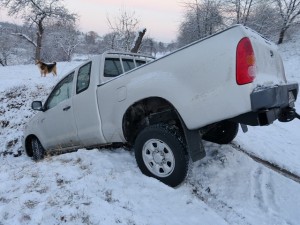 According to the Federal Highway Administration (FHA), over 1,300 people are killed, and more than 116,800 people are injured in vehicle crashes on snowy, slushy or icy pavement annually. In addition, each year some 900 people are killed and nearly 76,000 people are hurt in crashes during snowfall or sleet.
According to the Federal Highway Administration (FHA), over 1,300 people are killed, and more than 116,800 people are injured in vehicle crashes on snowy, slushy or icy pavement annually. In addition, each year some 900 people are killed and nearly 76,000 people are hurt in crashes during snowfall or sleet.
Accident Prevention
While we can’t control the weather, we can control some of the factors which contribute to winter accidents. Accident prevention starts before even getting in the car. It starts where the rubber meets the road — your tires.
Tires
At the very minimum, winter driving requires tires that have adequate tread and proper inflation. Worn tires and slippery roads are dangerous combination. Under-inflated tires can compromise handling, and lead to tire failure and blowouts.
If the winter temperatures where you live are regularly below 45F degrees, it is recommended that you invest in a set of winter tires. These tires feature tread patterns specifically designed for icy or snowy conditions. They are also optimized for low temperatures. Their special rubber compounds stay pliable in the cold, resulting in better grip and improved braking.
Windshield wipers
Good visibility is essential for safe driving. Approximately 20% of road accidents are caused by poor visibility. Windshield wipers need to be able keep your windshield free of snow and ice. Consider purchasing wiper blades best suited for winter conditions and replace worn wipers.
Check the level of your windshield washer fluid on a regular basis. Use a winterized window washer fluid so it won’t freeze.
Make sure to clean the windshield on inside of the car. Spots and streaks on your windshield can make it virtually impossible to see in certain sun glare situations.
Defroster
During winter months, one of the most important systems in your car is the defroster.
It clears the windows of ice or condensation. A malfunctioning defroster could create hazardous driving conditions, making it near impossible to see clearly.
Other car components that should be in good working order include lights, brakes, and the battery.
Before Taking to the Road
Clear any snow and ice off your car. Failure to do so could result in the snow or ice sliding off and obstructing your vision or striking another vehicle.
A recently enacted Pennsylvania law — known as “Christine’s Law” — requires the removal of accumulated ice or snow from the motor vehicle or motor carrier vehicle, including the hood, trunk and roof.
When snow or ice is dislodged or falls from a moving vehicle or motor carrier vehicle and strikes another vehicle or pedestrian causing death or serious bodily injury, the operator of the vehicle from which the snow or ice is dislodged or falls from will be subject to a fine of not less than $200 nor more than $1,500 for each offense.
Under “Christine’s Law”, drivers may be stopped on a highway if the police believe the accumulated ice or snow may pose a threat to people or property. A fine of $50 is imposed regardless of whether any snow or ice dislodges from the vehicle.
In addition, injuries caused by ice or snow on someone’s car, can give rise to a lawsuit.
On the Road
To make your drive safer:
- Drive slowly on slippery roads.
- Avoid sudden stops and starts.
- Accelerate and decelerate slowly.
- Increase following distances.
- Don’t “power” up a hill. (Build up some momentum before you get to the hill.)
- Don’t stop going up a hill, unless absolutely necessary.
- Proceed down a hill as slowly as possible.
- Beware of “black ice.”
- Use extra caution on bridges and ramps, where ice can often form without warning.
- Use your turn signals to let other motorists know where you’re going.
- Don’t use cruise control.
- Minimize distractions.
- Be aware of state-enacted road restrictions and plan on your driving trips taking a little longer than usual.
Legal Liability for Winter Accidents
Typically, the driver at fault in a crash caused by sliding on a slippery road is the driver of the striking vehicle. Drivers have a duty to drive safely and appropriately no matter what the conditions. Every driver must act with due care based on the conditions of the roadway. Unless the ice and snow is considered unexpected or unforeseen, the person deemed to have caused the accident is held responsible.
If the roadway was not salted or plowed in a timely manner the appropriate governmental agency could share liability. This is also the case if poor design or improper maintenance allows water to drain then freeze.
If you were involved in an accident that you believe was caused by someone else’s negligence, call Comitz Law at 570-829-1111 or email info@comitzlaw.com. We can help.


